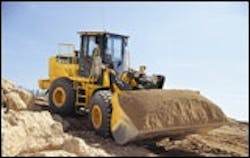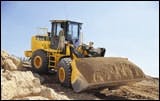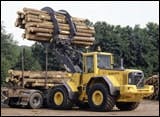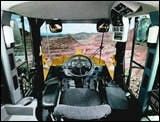No Bad Choices In This Lot
- Liebherr
- Volvo
- Case
- Hyundai
- New Holland
- Komatsu
- John Deere
- JCB
- Doosan/Daewoo
- Kawasaki
- Dressta
- Caterpillar
- Terex
- Intensus
- Changlin
- Cleaner engines, fuel economy
- Average List Prices and Hourly Rates
- 200-300-HP Wheel Loaders
If you've had occasion to operate any of the new mid-size wheel loaders in today's market, you might agree that most have several fundamental characteristics in common: they're powerful and smooth as glass to run; cabins are comfortable, convenient and exude a sense of refinement; and most exhibit a just-right blend of tractive effort and hydraulic power that let's you charge the pile aggressively and heap the bucket quickly with virtually no wheel spin.
On top of this, as a group, they're competent at any number of tasks, more environmentally friendly than ever before and, overall, probably easier and less costly to maintain than their predecessors. We're defining "mid-size" here as models with net horsepower ratings of 200 to 300, a range that includes models on the low end with standard buckets of, say, 3.5 to 4.0 cubic yards, and machines on the high side with standard buckets typically in the range of 5.0 to 6.0 cubic yards.
But your choice of buckets for these versatile models is usually quite broad, and can range from smaller rock buckets to light-material configurations that provide capacities well in excess of standard ratings. And in most instances, these machines are available with a high-lift-boom option, which particularly suits them for loading bulk materials into high-volume trailers.
While most mid-size loaders will spend their lives with a pin-on bucket in material-handling operations, they're more than capable of taking on a wide range of tasks. A sizeable market for these machines, for example, is waste handling. For models on the upper side of our arbitrary horsepower scale, for instance, scrap handling is big business. Equipped with solid tires, a set of special forks and extra guarding for the cab and power train, these machines are adept at handling auto carcasses and all other manner of scrap metal. Or in yard-waste-processing operations, models typically on the smaller end of our scale may be loading stumps and log sections into tub grinders, or using large specialty buckets to load green waste into horizontal grinders and shredders.
In the aggregates industry, you'll not only frequently find these machines handling sand-and-gravel, but also doing some fairly demanding work in rock quarries. Or, fitted with grapple forks, these loaders become natural log handlers in forestry applications.
Most every conventional wheel loader, of course, can be made even more versatile with the addition of a coupler, allowing it to switch quickly between work tools — more often than not between a bucket and a set of forks, but sometimes between different bucket types, or perhaps between a bucket and a specialized work tool, such as a lifting jib, grapple or rotary broom. The coupler, however, may not be a good investment for every wheel-loader user, and installing a coupler should be predicated on frequency of use and economic considerations — that is, how much time will it actually save you, and how much extra production will it allow.
The Environmental Protection Agency (EPA) set January 2006 as the date for off-road diesel engines in the range of 174 to 301 horsepower to be Tier-3 compliant. Thus, most of the models listed in the accompanying spec table use a Tier-3-compliant engine, but perhaps not all — yet.
According to Bruce Farrar, manager of off-highway communications for Cummins (whose engines from 174 to 751 horsepower are Tier-3 compliant), the EPA has given certain engine manufacturers and equipment makers limited extra time for completely complying with Tier-3 standards. The EPA has done this with two "flexibility" programs: Averaging, Banking & Trading (for engine manufacturers) and the Transition Program for Equipment Manufacturers, which detail strict guidelines for Tier-3 implementation.
Probably safe to say, however, is that those models not now equipped with a Tier-3 engine, soon will be. For wheel-loader buyers, this may be a point of no consequence, unless local air-quality standards specifically mandate the use of Tier-3 power. What may concern the wheel-loader user, though, is how Tier-3-engine fuel consumption will compare with that of previous engines.
Engine manufacturers have taken various technical routes to Tier-3 compliance, and it's probably safe to say that the specific technology employed will affect the engine's fuel usage. But, in general, say most engine manufacturers, Tier-3 fuel economy is on par with that of Tier-2 and, in some instances, might be better.
If, for example, a mechanically injected Tier-2 engine is replaced with a Tier-3 version having electronic fuel injection, fuel economy may well improve.
But the real concern of the wheel-loader buyer should be fuel efficiency, that is, the amount of material moved per gallon of fuel. Fuel efficiency involves not only the fuel-usage characteristics of the engine, but also how efficiently the overall design of the machine utilizes available horsepower. For example, more wheel loaders today are being equipped with hydraulically driven fans, which potentially can save significant fuel by operating only when (and at the speed) actually required, versus running continuously via a belt drive and, therefore, always draining horsepower.
Along with hydraulic fans, the use of variable-displacement piston pumps in the wheel loader's implement-hydraulic system is on the rise. These "load-sensing" systems conserve fuel by virtue of their pumps not moving any more oil than is actually required and, thus, using no more horsepower to drive the pumps than is actually required.
But, that said, about half the models listed in the accompanying spec chart employ gear- or vane-pump-type hydraulic systems, many of which also incorporate load-sensing features to improve efficiency and horsepower utilization. Gear- and vane-pump systems remain effective, durable and economic in design, and continue to serve wheel-loader users well.
Hydraulic-control systems also have received considerable attention in today's mid-size wheel loaders. Conventional two-lever designs (separate levers for boom and bucket control) typically use short-throw, low-effort levers that often are pilot operated. Most machines also offer a single joystick controller, which may be electric-over-hydraulic in operation.
Along with hydraulic controls, the cab environment, generally, for these machines continues to be refined. On the list are more effective HVAC systems, enhanced visibility, transmissions with flexible automatic-shift capability, adjustable transmission-cutoff settings, and electronic monitoring systems that provide up-to-the-second information on operating parameters. These electronic systems also may allow extensive diagnostic investigation, as well as the capability to tailor machine settings to the individual operator.
And as a final — but vitally important — aspect of these machines, routine serviceability is less of a chore. Assisting in this regard are features such as ground-level access to routine service points, extensive use of sight gauges, central lubrication banks, vertical spin-on filters, remote drains, remote pressure taps and easily accessible oil-sampling ports.
Considering the overall design of today's mid-size wheel loaders, you might say that they are characterized by an attention to detail, which, in the final analysis, makes them more productive.



